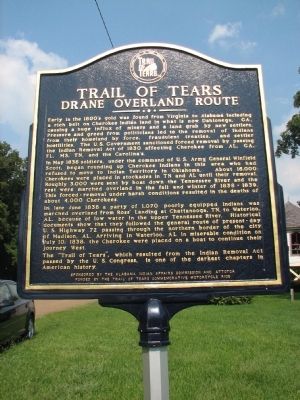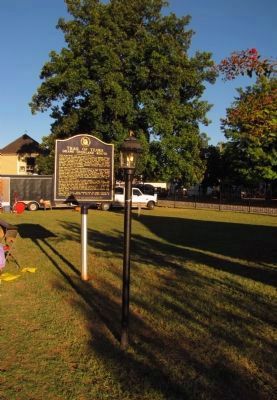Madison in Madison County, Alabama — The American South (East South Central)
Trail of Tears
Drane Overland Route
In May 1838 soldiers, under the command of U.S. Army General Winfield Scott, began rounding up Cherokee Indians in this area who had refused to move to Indian Territory in Oklahoma. About 16,000 Cherokee were placed in stockades in TN and AL until their removal. Roughly 3,000 were sent by boat down the Tennessee River and the rest were marched overland in the fall and winter of 1838~39. This forced~removal under harsh conditions resulted in the deaths of about 4,000 Cherokee.
In late June 1838 a party of 1,070 poorly equipped Indians was marched overland from Ross' Landing at Chattanooga, TN to Waterloo, AL because of low water in the upper Tennessee River. Historical documents show that they followed the general route of present ~day U.S. Highway 72 passing through the northern border of the city of Madison. Arriving in Waterloo, AL in miserable condition on July 10, 1838, the Cherokee were placed on a boat to continue their journey West.
The "Trail of Tears" which resulted from the Indian Removal Act passed by the U.S. Congress, is one of the darkest chapters in American History.
Erected by Sponsored by the Alabama Indian Affairs Commission and Attotga Funded by the Trail of Tears Commemorative Motorcycle Ride.
Topics and series. This historical marker is listed in these topic lists: Government & Politics • Native Americans. In addition, it is included in the Trail of Tears series list. A significant historical month for this entry is May 1838.
Location. 34° 41.64′ N, 86° 44.936′ W. Marker is in Madison, Alabama, in Madison County. Marker is on Front Street close to Church Street. Located on Front Street inside the City Park next to the Roundhouse. Touch for map. Marker is in this post office area: Madison AL 35758, United States of America. Touch for directions.
Other nearby markers. At least 8 other markers are within 3 miles of this marker, measured as the crow flies. "The Roundhouse" (here, next to this marker); Madison County Veterans (within shouting distance of this marker); Affair at Madison Station / Affair at Indian Creek Ford (within shouting distance of this marker); Old Madison Cemetery (approx. 0.4 miles away); Pension Row (approx. 0.4 miles away); Madison Cemetery (approx. half a mile away); James Henry Bibb (approx. 0.7 miles away); Lee Mansion (approx. 2.6 miles away). Touch for a list and map of all markers in Madison.
Also see . . . Trail of Tears. The Trail of Tears was the relocation and movement of Native Americans, including many members of the Cherokee, Creek, Seminole, and Choctaw nations among others in the United States, from their homelands to Indian Territory (present day Oklahoma) in the Western United States. The phrase originated from a description of the removal of the Choctaw Nation in 1831. (Submitted on March 18, 2010, by Sandra Hughes Tidwell of Killen, Alabama, USA.)
Credits. This page was last revised on June 16, 2016. It was originally submitted on March 18, 2010, by Sandra Hughes Tidwell of Killen, Alabama, USA. This page has been viewed 2,535 times since then and 85 times this year. Last updated on July 20, 2015, by J. Makali Bruton of Accra, Ghana. Photos: 1. submitted on March 18, 2010, by Sandra Hughes Tidwell of Killen, Alabama, USA. 2. submitted on October 4, 2010, by Lee Hattabaugh of Capshaw, Alabama. • Bernard Fisher was the editor who published this page.

